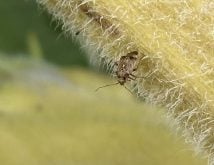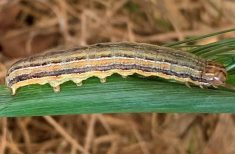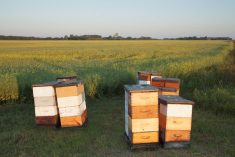Frank, who grows durum wheat, lentils, canola and soybeans south of Regina, Sask., called me mid-August in 2016 to discuss an issue with his wheat crop. He noticed white wheat heads popping up randomly throughout the field.
“Could this be from heat blast, like in canola flowers?” he asked. “There are more of these heads showing up every day.”
I made my way out to Frank’s farm that day. From a distance, I thought the crop looked perfectly healthy, and had developed a good plant stand. When I examined the plants with the white heads, I found they were completely sterile and felt crispy, yet they were attached to a healthy, green plant.
Read Also

Claas brings 1000 Series SP forage harvesters to Canada
In mid-August, Claas unveiled its new line of Jaguar forage harvesters at an event in Visalia, California, deep in the heart of that state’s dairy region.
Several possibilities came to mind when I considered factors that could cause whitened heads. For instance, had hail caused the injury to the wheat heads? Or had the plants contracted aster yellows, a disease caused by a bacteria-like pathogen called a phytoplasma? I also had to consider the diseases fusarium head blight and take-all root rot as white heads are a symptom of both diseases.
Recently, a few storms had travelled through the area. Hail could have hit the plants and damaged the stems, thus impeding the supply of water and nutrients to the wheat head. This lack of resources could then cause the heads to turn white.
However, eliminating hail damage was easy. After talking with Frank and other growers in the area about recent weather events, I determined the storms did not produce significant hail damage. In addition, the crop didn’t show any signs of physical damage from hailstones on the outside of the stems.
In Saskatchewan, aster yellows disease is most commonly transferred to plants by the aster leafhopper. This insect vector lands on the plant head and transfers the aster yellows pathogen to the plant head, turning it white.
To eliminate this disease as the source of plant injury, I pulled upwards on a plant’s head, which detached easily from the stem. Had the plant been infected with aster yellows disease, the stem wouldn’t have detached easily from the plant.
While FHB, a fungal disease, can cause wheat heads to appear whiter than their healthy neighbours, the affected heads are often not as vivid in wheat in the early stages as were presented here. Also, there were no signs of orange fungal growth on affected heads and kernels, normally associated with FHB.
Furthermore, if this field had been infected with FHB, I’d expect to see more damage. In the past, this region had experienced harvested samples with more than 20 per cent fusarium damaged kernels. In this field, the affected plants occurred randomly and the damage was insignificant — it looked worse than it was.
Plants infected with take-all root rot, another fungal disease, come away easily when pulled out of the ground. Infected plants’ roots and crowns can also turn black in colour. These symptoms were absent in plants from this field and the root systems looked healthy. Also, like the head and stem “pull test” for aster yellows disease, when I pulled on a wheat head, it detached easily from the stem, indicating take-all root rot was not responsible for the plant damage.
This simple pull test, while eliminating aster yellows disease and take-all root rot, was my first big clue to the real reason why the wheat heads in Frank’s crop were turning white.
Crop Advisor’s Solution: It’s unsightly, but it’s not affecting yield
I pulled the stem of an affected plant out of the sheath of the flag leaf. The bottom few inches were brown and rotten at the stem’s base and there appeared to be evidence of shredded plant material at the point of disconnection. Then, upon splitting open the stem, I found larvae feeding inside — wheat stem maggot larvae!
The larva’s adult form is a small fly that lays one egg per stem near the sheath of the flag leaf. The maggot that hatches from the egg burrows into and feeds on the stem, cutting the head off from water and nutrients supplied by the roots and lower leaves, causing the head to turn white.
There wasn’t a lot Frank could do to eliminate this pest problem. No economic control methods are available for wheat stem maggot. To spray for the adult form of the pest would be difficult because of the mobility and movement of flies and therefore not economical. The good news is, generally, wheat stem maggots do not occur in large enough amounts to significantly affect yields.
Because wheat stem maggot overwinters on cereal stubble, if Frank wanted to lower pest populations, stretching out the rotation between cereal crops would help. However, while rotation away from cereal crops may help keep populations down, it isn’t necessarily practical when considering the whole farm operation and all crops and pests.
Visually, Frank wasn’t thrilled about how the crop looked — the white heads of the affected plants stood out prominently against a backdrop of healthy, green plants. In reality, the proportion of affected plants was very insignificant; it looked far worse than it was. And, as the crop matured, the heads became less noticeable and there was no effect on yield. Therefore, in the end, Frank was happy. Also, he knows what symptoms to look for the next time as well as how to identify wheat stem maggot properly.















